

The knowledge system of Urban Planning-a Chinese planning textbook in the 20th century
Urban Planning was a novel academic domain for China in the early 20th century. Since then, scholars studied overseas continuously introduced western-rooted urban planning theories, notions and techniques to China by translated literature, planning practice and teaching. In the 1920s, the subject of urban planning was promoted under the programmes such as Civil Engineering and Architecture, meanwhile, textbooks translated from foreign languages were commonly used in the teaching. Following Yuanpei Cai, the principal of Peking University called for university textbooks in the Chinese language in the 1930s, ‘the university textbook series’ was published. Becoming one of the book series in 1940, Urban Planning, as a textbook of the school of Civil Engineering, was the sole urban planning textbook self-produced by Chinese scholars until the 1980s. Writing in the form of lectures’ handouts in 1936, the textbook was formally published in 1940. Eight editing versions were produced by the Commercial Press in the following 42 years, and it was not until 1978, the final edit was published (Figure 1).
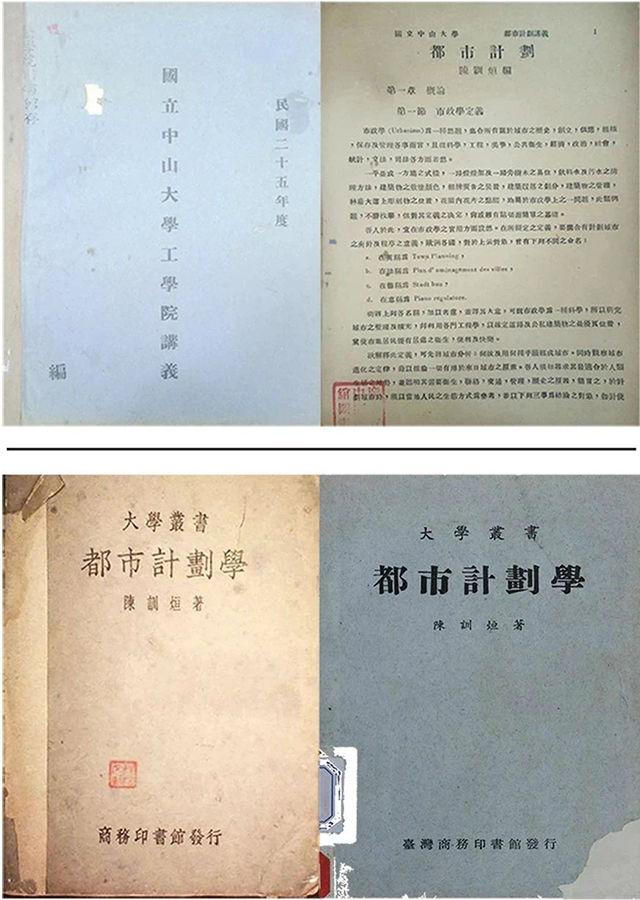
the cover and front page of the handout of Urban Planning (Xunxuan Chen, 1936), and the cover of the textbook of Urban Planning (Xunxuan Chen, 1940/1978)
The subject of urban planning had not been founded as an independent programme yet in the first half of the 20th century, its knowledge system was regarded as an extension of Civil Engineering. This textbook-Urban Planning broadly absorbed the cutting-edge theories at that time, which at present is the key source to understand the knowledge system of Chinese urban planning in the 20th century. This article aims to reflect the contents and characteristics of urban planning knowledge in the early stage of modern China and provides inspirations for the construction of planning subjects.
1.The author-Xunxuan Chen
Xunxuan Chen, styled himself as Tuo’an, was born in Minhou, Fujian Province. Following obtaining a bachelor’s degree of Science from Aurora University in Shanghai, Chen started his study in the Civil Engineering School of Ecole Spéciale des Travaux Publics in 1930. He completed his Ph.D. in 1934 and gained several internships overseas. In 1935, Chen accepted the invitation of his friend Ditang Fang who was the Head of the Department of Civil Engineering of Sun Yat-sen University to be a professor after returning to China in June (Figure 2).

News-Xunxuan Chen returned to China after completing his Ph.D. degree
In September of 1939, Chen was appointed as an engineering to the Sichuan-Yunan highway management office in the Ministry of Transport, meanwhile, he worked as a professor in the Department of Civil Engineering of Sun Yat-sen University for a month. In February 1942, the Bureau of Sichuang-Yunnan Highway established the Xichang branch of the Chinese Engineering Society for industrial constructions of national defense and mining and metallurgy etc., Chen worked as a clerical officer in the Xichang branch. After the Victory over Japan Day, Chen migrated to Taiwan in November 1945 as the first group of ‘receiving specialists’ approved by the National Government Resources Committee. In 1952, Chen completed his work-Chinese Water Resource Development Approaches. In November 1953, Chen participated the consultation of legislation of Taiwan Province and drew a draft of the Regulations of the Implementation of Urban Land Reform, working as a member of the urban planning professionals of an inspection group. In March 1968, Chen was engaged as the first principal of the Chung Hwa Technical Private College, after this he was retired in February 1977.
2.The content of the Urban Planning
The first edit of Urban Planning in 1940 was adapted from the handouts of urban planning lectures in 1936. The original lectures’ content includes twelve chapters with 164 pages, and the edited version consists of 18 chapters and 270 pages of body paragraphs (Figure 3). The textbook is composed of four sections: a) chapter one and chapter sixteen explain the concept of cities and urban planning; b) chapter two to five and chapter fifteen introduce the preparation, urban evaluation, urban structures, zoning, areas, and aesthetics; c) chapter seven to chapter thirteen demonstrate the knowledge of sub-planning in buildings, roads, junctions, squares, urban parks, transport; d) chapter fourteen, seventeen and eighteen include knowledge about urban sanitation, garden cities and modern air defense plans.
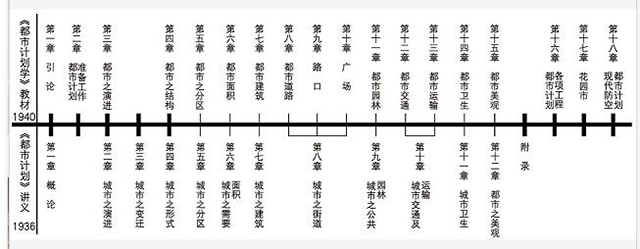
A comparison of framework of the Handouts and the textbook of Urban Planning
(1)The concept of city and urban planning
The textbook replaced most of the term ‘city’ used in the handouts with ‘metropolis’. These two terms only turned up together in chapter one, notably, the use of ‘city’ emphasized the political meaning of cities, including Thebes in Egypt, Babylon, Knossos in Greece, Florence, and traditional city in China such as Gaolan, Xi’an and Kaifeng; on the other hand, the textbook referred metropolis as cities with modern economic functions, such as London, Paris, Berlin and New York which experienced the influence of Industrial Revolution.
The handouts were named Urban Planning, but the concept of ‘Urbanism’ was hardly used. This is because the author regarded ‘Urbanism’ as the other interpretation of the meaning of urban planning, though it paid more attention to the planning of roads and buildings. While the textbook employed the term ‘(the subject of) urban planning’ and defined the terminology as the knowledge to ‘create, manage, expand and beautify metropolis’. Comparing to ‘Urbanism’, the meanings of creation and beautification were added in (the subject of) urban planning, which indicates the chief characteristics of the urban planning subject in the promotion of new town planning and urban arts.
(2)The procedure of urban planning and planning content
Compared with the handouts, a new chapter two was added to the textbook, and the original chapter three and four were modified to outline a more comprehensive knowledge structure from the perspective of social development. The modified content includes planning procedures of surveys, urban development and urban structural analysis, as well as the knowledge about urban zoning and the prediction of urban scales (Figure 4). The textbook considered urban scales as the top one difficulty, and it founded an index on the basis of the population to predict the scale (Figure 5); the textbook stressed that the proportion of roads is the key of urban land use, and it proposed the ratio needs to be limited in between 25 per cent and 33 per cent, the minimum figure was identical to the Paris’ level, and it was higher than the 1939 Law of Urban Planning (20 per cent).

the procedure and content of urban planning
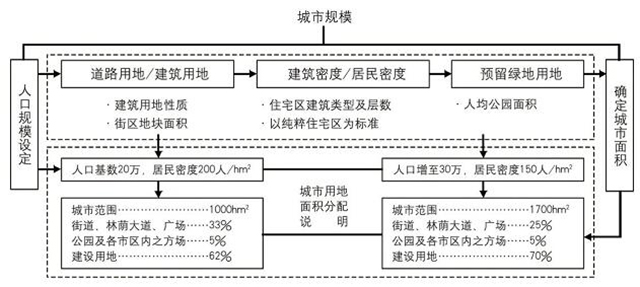
the Index to estimate urban scales
The sub-planning was introduced from three aspects by seven chapters, covering residential planning, road and traffic planning, parks and green land planning (Figure 6). There are 147 out of 287 pictures illustrating the planning of residences and roads, meanwhile, a large number of equations were provided to explain key points. Noticeably, residential and traffic planning were constantly the core techniques and theories of urban construction in the 20th century. As the textbook noted, ‘all infrastructures need to meet the demands of modern cities and enable future developments’, which demonstrated the goals of engineering planning in modern construction.
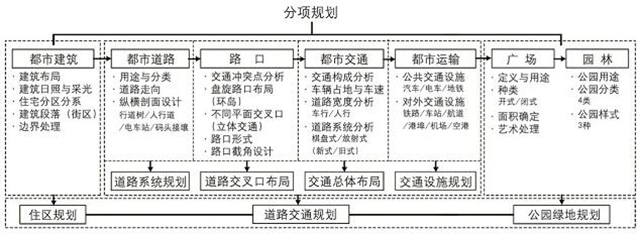
the knowledge system of sub-planning
(3)The novel knowledge of urban planning
The textbook engaged three new discourses of urban planning: urban sanitation, garden city, and air defense planning. The textbook claimed that traditional Chinese cities failed in building sanitation facilities, and it suggested the public health was an effective approach to reduce illness and fatalities. It was necessary to provide urban open spaces by arranging layouts of public buildings in accordance with the three elements of nature (i.e. geology, water sources, and air or wind direction). The textbook noted, the notion of garden city was not only a popular urban model and governance strategy in post-war Europe, but urban construction aims and guidelines of Chinese planning communities, which became the focus of the planning academics in the 20th century. In addition, the textbook regarded air defence as a vital rule of planning and theme during wartime, accordingly, it proposed a dispersed urban model in order to reduce the building areas and volumes to avoid destruction.
3.The knowledge sources of Urban Planning
First of all, one of the sources of the textbook was the translated textbooks used in Chinese universities in the 20th century, including Town Planning in Practice, Principles of City Planning, and City Planning. All these materials were the foreign textbooks introduced to urban planning subjects of the programme of Civil Engineering and Architecture in the 1930s, which at the same time were the references of the Handouts in Chen’s lectures, especially the Town Planning in Practice and Principles of City Planning. Thus, the mindset and logic of the Handouts showed similarity to the texts (Figure 7).
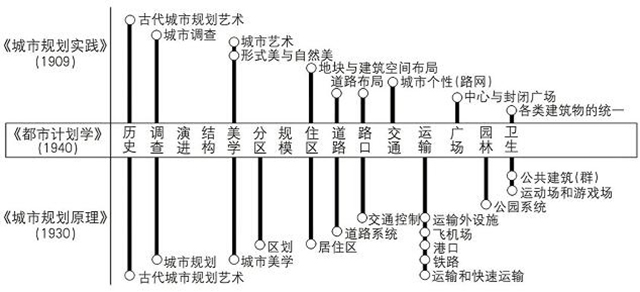
A comparison of knowledge system of the Urban Planning, Town Planning in Practice, and Principles of City Planning
Secondly, the knowledge system of the textbook was influenced by French planning methods, given the author gained degrees in France. The theories relevant to French cases were introduced, including the L’ Urbanisme in 1910, planning techniques and methods with aestheticism, the designing of Boulevard, the calculation for roundabouts and traffic flow, the theories of lighting and architectural space, urban open space, air defense planning, urban sewage treatment methods, and the principles of the waterscape, etc.
Finally, the latest practice of urban planning in China was also included. Given road planning, residential construction, and engineering planning were the primary goals of urban planning in the 20th century, these sections constituted the key knowledge of the textbook.
4.the values of the textbook
The editing of the textbook witnessed the establishment of the Civil Engineering programme in Chinese universities, the use of translated foreign textbooks, and the development of the localized teaching materials, it engaged the most urban planning theoretical knowledge in the 20th century. The author concluded the modern planning knowledge system and edited the textbook on the basis of the context and circumstance of Chinese urban construction.
With the influence of western planning notions, urbanisation and modernisation were promoted in China in the 20th century. The textbook, Urban Planning, reflects a shift in the understanding of urban planning paradigms in academia. This leads to the generation of an urban planning knowledge system that fits the context of modern China and adds new knowledge to the subject which was dominated by western philosophy.
What were stressed as important ideologies, including planning scopes and careers, conservation of historical and natural landscapes, are still influential in the field to date.
Moreover, a knowledge system constantly plays a key role in the work of textbook authors and educators in the planning field. It is an urgent task to position the subject of planning and update the knowledge system in this new era when ecological civilization and national spatial planning are promoted. For one thing, the subject should improve the interdisciplinary interaction in education scientifically, engaging domains including economics, society, ecology, geography, environment, management, laws, etc. to the programme. For another, the core courses and knowledge system of urban planning education need to consider career developments and the demands of society. The standard of courses should be designed and revised to meet the requirement of our society.
Translated by Liang Xiuchun